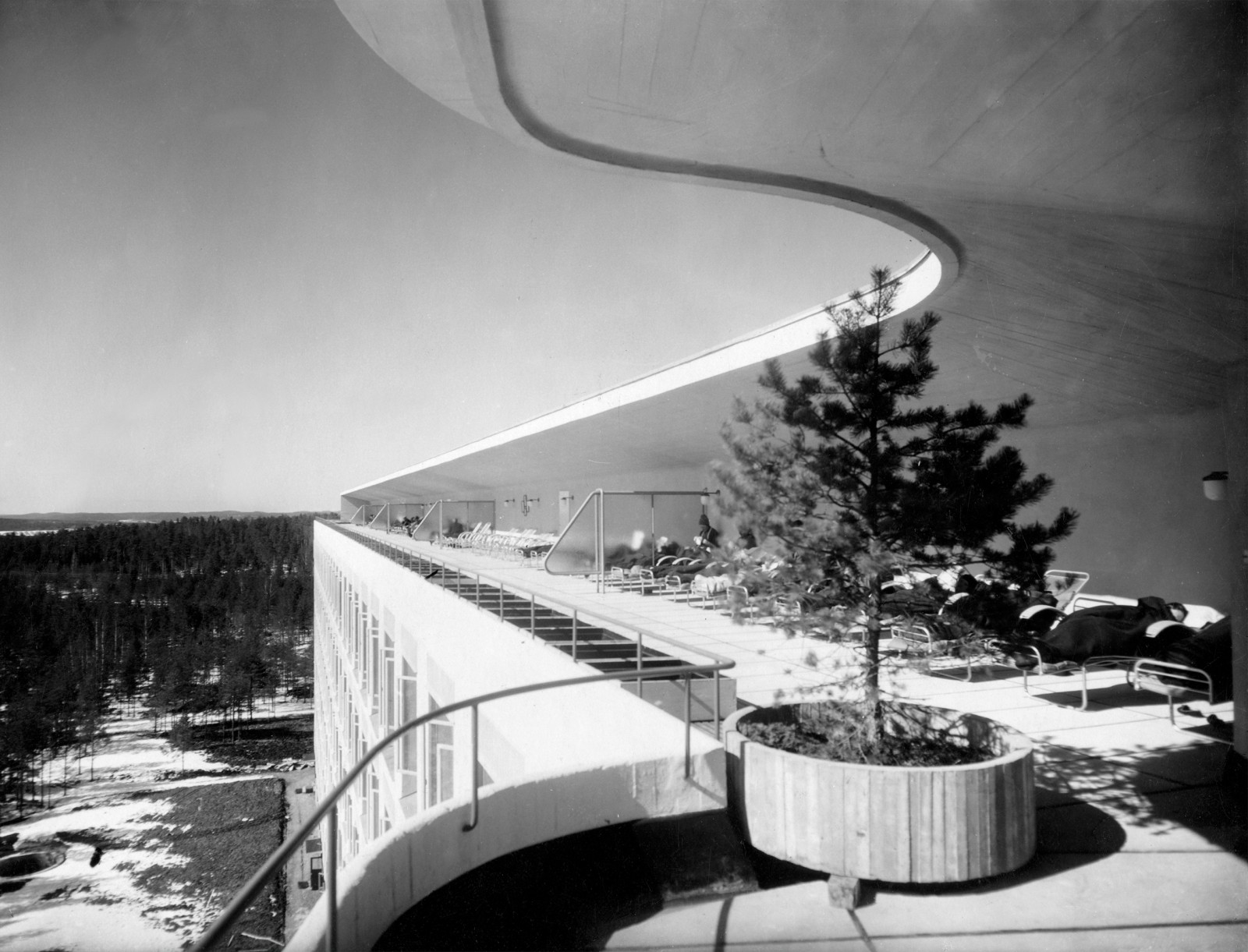Take Alvar Aalto and Aino Aalto and their Paimio sanatorium of 1929 in Finland. With its dramatic terraces in the sky, the building even bears an uncanny resemblance, in canonical photographs, to ribs in an X-ray, the primary diagnostic tool for TB. Its clean-lined bedrooms, void of ornament, were designed to minimize surfaces where dust could accumulate Even the intersection of floor and wall beneath the window curved to stop dust build up. The rooms were equipped with furniture and sanitary fittings designed by the architect, including chairs whose back was angled to facilitate breathing and expectoration, sinks designed to reduce splashing and spittoons to minimize sound. Even door handles were carefully designed not to catch the sleeves of the doctor’s white coats.
But the building’s main equipment was the top-floor terrace, seven stories above the forested landscape, where patients were wheeled out for regular doses of fresh air and sun in the specially designed lounge chair by Aino Aalto. [FIG. 5] Eventually, the terrace had to be closed off perhaps because the nurses couldn’t keep up with the number of desperate patients throwing themselves from it every time they turned their backs. Modern architecture as a form of assisted suicide? The discovery and success of streptomycin in 1944 revealed that there was little scientific basis to the air and sun therapy of the sanatorium.Sometimes it even precipitated the end. At Paimio, quite literally.
Tuberculosis made modern architecture modern. It is not that modern architects made modern sanatoria. Rather sanatoria modernized architects. Aalto was a neoclassic architect before his “conversion to functionalism” in the 1927 competition entry for a tuberculosis sanatorium at Kinkomaa, Finland—an unrealized project of horizontal lines and wide terraces for the cure, that anticipates Paimio. For Aalto, the sanatorium was not architecture in the service of medicine but a form of medicine in its own right—a medical instrument: "The main purpose of the building is to function as a medical instrument… The room design is determined by the depleted strength of the patient, reclining in his bed
[3]."
Aalto himself had been sick at the time of the competition for the building and claimed that having to lie in bed for an extended period of time had been crucial to his understanding of the problem. Architecture was always conceived for the vertical person but here was a client permanently in the horizontal. [FIG. 6] The whole design of the room and the building had to change accordingly. Light fixtures could not remain in the ceiling irritating the eyes of the occupant lying in bed and for whom the ceiling had all of a sudden acquired maximum importance—a new kind of façade perhaps. The view through the window to the forest outside also had to be calculated from the point of view of the bed. In the terrace the low parapet and thin rail above allowed the eye of the horizontal person to travel far above the forest.
The colors of the room and the building had to be thought in these terms too. Soothing “quiet, dark hues” of blue for the ceiling. The walls in lighter shades. Bright canary yellow in the reception booth by the entrance and in the linoleum of the lobby, staircase and corridors evoked “sunny optimism even in cold, cloudy days.”
[4] Psychological factors were also carefully considered: "An extended period of confinement can be extremely depressing for a bed-ridden patient. …A tuberculosis sanatorium is, to all intents and purposes, a house with open windows
[5]."The hospital has to be thought as a new kind of house. And in reverse, the generic house needs to be a sanatorium. Aalto later wrote: "I was able to discover that special physical and psychological reactions by patients provide good pointers of ordinary housing…. To examine how human beings react to forms and constructions, it is useful to use for experimentation especially sensitive persons, such as patients in a sanatorium
[6]."
The bodily and psychological sensitivity of the sick person is used to recalibrate architecture. Even the specialized furniture became ordinary every day pieces. If the cantilevered birch wood Paimio chair for example, was designed to open the chest of the patient, allowing them to breathe easier, soon enough that chair became everybody’s chair. Likewise with the rest of the furniture specially designed for Paimio: “The sanatorium needed furniture which should be light, flexible, easy to clean and so on. After extensive experimentation in wood, the flexible system was discovered… to produce furniture which was more suitable for the long and painful life in a sanatorium.”
[7] A workshop was set up with a local company to carry the first experiments and in 1935, barely two years after completing Paimio, Alvar and Aino Aalto founded the Finish furniture company Artek, with “the ambition to support and nourish human beings’ physical and psychological wellbeing
8]."The reference point was the seriously ill. Aalto claimed that the architect had to design for the person in the “weakest position.” The tuberculosis patient becomes the model for modern architecture. In other words, sickness was no longer seen as the exception but as the norm—and varying degrees of sickness define the human condition. The modern subject has multiple ailments, physical and psychological, and architecture is a protective cocoon not just against the weather, and other outside threats, but in modernity, more notably about internal threats: psychological and bodily ailments.
Aalto compared his experiments in Paimio and their application to everyday use to the “exaggerated” forms of analysis that scientists use “in order to obtain clear more visible results,” such as “stained bacteria” for microscope examination.
[9] He sees design as a form of medical research with the sanatorium acting as a kind of research lab for modern architecture—a way of testing architecture, looking at what has been hidden, exposing the invisible forces.
The relationship between architecture and the human body is always intimate. With modern architecture this intimacy deepens as the body now includes invisible microbes. Indeed, the real clients of modern architecture are invisible. Sigmund Freud, X-ray, bacteriology and the germ theory of disease all emerged in the same short period of time, and they are all about looking inside, acknowledging the invisible: the unconscious, the skeleton, the microelement of bacterial and the bacillus of TB.
Architecture, likewise, turns itself inside out. The threat is no longer outside but inside in the invisible. The micro scale of the bacteria becomes the base for furniture, houses and cities: the micro and the macro: the bacterium and the city. Cities were suddenly thought to be teeming with unseen occupants that in that sense became the new clients of modern architecture and urbanism.
The architect became a bacteriologist. Architectural itself became bacterial. As Le Corbusier put it, he needed to do “laboratory work,” “isolating his microbe” until it appear in “undisputable clarity.” Those are all his words, then he goes on to say that with this one can make a “diagnosis” and draw up the fundamental principles of modern city planning. Modern architecture goes from microbe to city and back
.[10]Modern architecture lying down is not just the new paradigm of seeing architecture from the point of view of those in the weakest position, the horizontal patient as paradigmatic client, but seeing the human species itself as weak, fragile, vulnerable, and immersed in bacteria. The human is no longer the center of a geometric system, but permanently hospitalized—a complete reversal of Leonardo da Vinci’s visualization of the Vitruvian man or even its reincarnation in modern times in figures such as Le Corbusier’s Modular Man. The clearly defined athletic, vertical, gendered, man gives way to a multiplicity of age, sexuality and physical and mental conditions in multiple combinations and collaborations with other species. Sickness is not the negative term but the generator of new potentials, the very engine of modernity
.In the book "Soutenir. Ville architecture et soin" published by the Pavillon de l'Arsenal in 2022.








